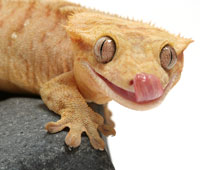Crested geckos continue to grow in popularity.
When REPTILES magazine first began publication in 1993, green iguanas were the “it” lizard. Then, as the years progressed, leopard geckos and bearded dragons took over, especially as more people learned that while still cool lizards, green iguanas really had some special care requirements in order to thrive. “Beardies” and leopard geckos then became the go-to lizards.
Nowadays, as you walk around any reptile expo, I’m sure you’ll notice a lot of crested geckos (Rhacodactylus ciliatus) have been showing up inside those deli cups. Leopard geckos and bearded dragons are still super popular, but over the past couple years, crested geckos have really come into their own — and why not? Crested geckos are available in assorted colors, they don’t get huge (an important trait for many reptile hobbyists who may not have much room in which to house animals) and their care requirements are not difficult to meet. Not to mention the fact that they are rather bizarre looking, adding to their appeal. For many reptile hobbyists, the more bizarre looking, the better!
According to Philippe de Vosjoli, in his book, Crested Geckos (Advanced Vivarium Systems, 2005), most of the “cresties” in captivity originated with specimens from the Isle of Pines (a small island near New Caledonia). The crested gecko naturally displays a variety of patterns and colors. This gave herpetoculturists an edge when captive breeding efforts were undertaken, and now you can find crested geckos exhibiting bright yellows, reds and other attractive colors.
The lizard gets its common name due to the distinguishing lateral crest that rims the eyes, the back of the head and neck, and onto the back of the lizard. The crest over the eyes is also responsible for an alternate common name: the eyelash gecko. They reach a total length of about 8 inches. A crested gecko enclosure must be secure because these guys can walk on glass, walls, etc. Like other geckos that have the same ability, a crested gecko’s toepads have thousands of tiny hairs, called lamellae, which allow them to walk upon hard and smooth vertical surfaces such as glass.
A couple of adult crested geckos can be housed in a 20-gallon vivarium. Live plants will make for an attractive setup and provide the lizards with hiding opportunities. Remember, pet reptiles need hiding places to feel secure. Without them they can stress out, which could cause them to stop eating and/or become sick. If you want to use live plants but don’t want to mess with planting them in a soil substrate, use potted plants. Of course, there are lots of nice-looking artificial plants available, too, if you prefer to go that route. The substrate could be any number of commercially available reptile substrates, such as orchid bark, which could be mixed with potting soil. Even newspaper could be used, for hobbyists more concerned with ease of cleaning over aesthetic appeal.
Crested geckos will eat the usual prey insects, but they also eat fruit and nectar. Pureed fruit baby food can be offered, alternating with the usual feeder insect menu of crickets and mealworms. Dust all meals, including live insects, with a calcium supplement to combat nutritional secondary hyperparathyroidism (aka metabolic bone disease). Because crested geckos can easily walk on smooth surfaces, consider placing live crickets in a bowl that is deep enough to prevent the crickets from crawling out. The geckos can then enter and exit the bowl easily, to eat the crickets at will, and the crickets won’t be able to run all over the enclosure while avoiding the lizards. Provide water in a shallow container.
Crested geckos don’t need hot spots the way basking lizards such as bearded dragons do, so full-spectrum fluorescent lighting over their enclosures will suffice. Heat tape or some other type of heating element may be necessary to maintain an ambient temperature in the mid-70s Fahrenheit, though if the room in which the enclosure is kept is in this temperature range, supplemental heat may not be necessary. Use a thermometer to keep track of temps.
One of the nice things about crested geckos is their willingness to breed in captivity. One of my past managing editors on REPTILES, Kara Sutton-Jones, came to the magazine without knowing anything about reptiles (believe me, it is very difficult to find someone with magazine editor experience and who also knows anything about reptiles). After working on the magazine for awhile, and attending reptile shows, Kara decided to try her hand at keeping a crested gecko. One eventually led to two, and before Kara knew it, she was finding eggs inside the enclosure. She successfully hatched them, and this went on for a few generations. She still was at it right up to the time she left REPTILES for greener pastures elsewhere, a now-veteran reptile breeder thanks to the crested gecko.
If you’ve never kept cresties and are looking for a new type of pet reptile, maybe you could follow in Kara’s footsteps.


